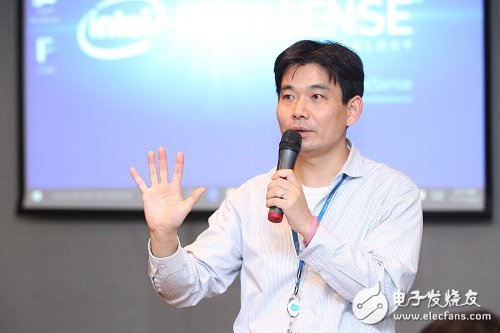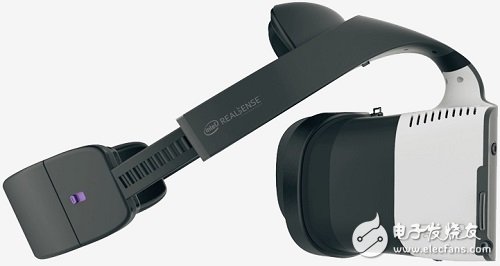In the transition period, Intel turned its attention to virtual reality (VR).
Intel, which previously focused on PCs, has been looking for the next new device that can replace PCs and smart phones after the loss of mobile chips. The smart devices that can be connected to the Internet are the main direction of its power, from smart bracelets and drones. After autopilot and robotics, Intel brought its overall solution in the VR/AR field and designed a corresponding reference device, Alloy. Intel called this program "Merged Reality".

Tang Zhenyu, Director of China, Intel Perceptual Computing Division
Tang Zhenyu, China Director of Intel Perceptual Computing Division, told Phoenix Technology that Intel's "converged reality" is not a simple combination of VR and AR, but this new technology has the ability to solve many problems in the current VR/AR field.
What is "integrated reality"?At the Intel Information Technology Summit (IDF) in August this year, Intel first proposed the concept of Meredic Reality. The so-called converged reality, that is, Intel hopes to allow users to feel their existence and the existence of the real environment in the virtual world. “Creating a new way of interacting with physical and virtual environments†is the official statement from Intel. In Intel's current "fusion reality", the user's hands are important interactive tools, users can see their own hands, can manipulate objects in the virtual world by hand, to achieve changes that are impossible in reality.
Inside Intel, a Project Alloy fusion reality reference design was used, using Intel's Skylake chipset for computer vision. This device is very similar to the virtual reality device currently on the market. The biggest difference is that it can be operated freely without being placed in a mobile phone or connected to a computer. Because there is no "wire for virtual reality devices", users can move over a wider range and have achieved six degrees of freedom for tracking and positioning. In addition, through the RealSense real-world technology that Intel pushed this year, the real-life camera in front of the device will allow the virtual scenes that the user sees to also contain real-world elements, help the user's barriers, and realize hand interaction.

Intel "Future Reality" device Alloy
To achieve the right integration between reality and virtuality, Tang Zhenyu said that Intel's real-world technology is the key. Real-world technology was officially launched at CES earlier this year. The vision of this technology is first to equip the device with eyes. In addition, it can be equipped with multiple senses such as hearing, touch, voice, and even emotions and emotions. At present, using real-world technology, Intel has developed cameras such as SR300, R200/LR200 and ZR300. These cameras include 1080P HD cameras, infrared cameras and infrared laser emitters. According to reports, these three cameras can help the device to perceive the depth of field like a human and capture the motion of objects. Also because of this technology, these "mixed reality" devices can help to avoid obstacles around them and recognize the movement of human hands.
In addition to "integrated reality" devices, Intel RealSense technology is also used in other fields such as robots, drones, autonomous driving, and intelligent driving.
Of course, only hardware technology is not enough for a complete set of "mixed reality" devices. As an open platform, Intel will also provide a complete software solution, including some visual algorithms, software solutions and a complete set of SDK. "Intel will provide end-to-end development solutions for partners, including hardware and software support," Tang Zhenyu said.
Related to "security"When talking about why to do "mixed reality" equipment, Tang Zhenyu believes that although both VR and AR are developing very hot, there are still many problems in the overall situation, and Intel hopes to use their existing computing power to solve these problems. problem.
The first is the problem of free movement. "Common devices will have nine-axis sensors, including accelerators, gyroscopes, etc., and all they can do is let the user see a cursor in the VR device. The helmet will move like a mouse on the PC desktop. But this is only the most basic, only three degrees of freedom, the result is that people are moving, but the virtual world is not moving, the experience of immersion is not very good," Tang Zhenyu said.
In addition, Tang Zhenyu believes that another problem with VR devices today is human-computer interaction. "The current VR device, either to do a æ‘ button on the device, some use a wireless mouse keyboard, or use a handle," Tang Zhenyu said. "But we believe that the most natural interaction is the interaction of gestures, especially when users are immersed in the virtual world without security, it is a very natural and comfortable response for users to see their hands."
Intel also has to solve the problem of users avoiding obstacles in the use of virtual reality devices, which is also related to user security. "Because of the depth camera, I can accurately know the distance of any one thing from me, so I won't hit it," Tang Zhenyu said. In addition, the real-world camera can also interact with multiple users in the virtual world. Therefore, it is also possible to achieve synergy or play in the game.
Tang Zhenyu told Phoenix Technology that Intel's converged reality is not a simple combination of augmented reality (AR) and virtual reality (VR), especially in terms of AR, Intel wants to do better, he said "if AR will really do Well, it can represent everything. But most ARs currently superimpose an image or projection on a real scene. But the big problem is that the interaction is very poor, and when the user moves, The original projection will disappear. The experience is very poor."
Intel hopes to achieve a seamless integration of VR and AR. The ultimate goal is to provide users with a virtual and real inseparable environment. "This is the highest level of convergence reality."
Determining "integrated reality" is the future trendNo matter whether it is VR or AR, there is no rapid development like smartphones in the early stage of the market, and it has gradually become popular. Now, these "real" products have encountered many development bottlenecks, such as how to solve the problem of wearing discomfort and dizziness, how to reduce costs and make the public acceptable. The influx of a large number of intelligent hardware manufacturers has made this area a slight "bubble", and the future development path is not clear.
But Tang Zhenyu believes that VR and AR will become a big trend in the future, and this is driven by human demand. "Humans will need such equipment, it can make you feel immersed, let you watch movies, and let you enjoy it comfortably. This is human needs," Tang Zhenyu said. "At first, no one would believe that a person still needs a PC, but there are hundreds of millions of PCs running around the world because people need to be accompanied by computing devices. This is the same for VR."
In addition, Tang Zhenyu also believes that the current manufacturers of such "real" helmets and content manufacturers are not doing very well. In his view, the reason why the so-called VR winter, investor withdrawal, etc., is mainly because most manufacturers are still doing the most basic technology, "if there is no differentiation, it will soon be overwhelmed. So Intel I hope to achieve a fundamental breakthrough in the basic technology, such as the six degrees of freedom tracking we have achieved, hoping to drive the industry to break out."
Intel CEO Brian Krzanich said in an interview with foreign media that he believes that although Intel's VR project is still in its infancy, it will eventually become Intel's key business.
Some recent moves also show that Intel is very ambitious in the field of "integrated reality." Recently, Intel has announced the acquisition of two related companies, visual processing chip startup Movidius, is nearing completion of the acquisition. Since then, it has announced the acquisition of Voke, a startup in the field of virtual reality. The company's Ture VR technology can provide 180° to 360° VR viewing experience, and has already experienced VR live broadcast in sports events. Tang Zhenyu revealed that in addition to the ability to interact by hand in the future, Intel's "integrated reality" will also add new ways of interaction, and will be announced later this year.
PoE managed industrial Ethernet Switches are configured with 1-24 10/100BaseTX/802.3af/802.3at compatible Ethernet ports, and each PoE port provides up to 15.4W/30W@48VDC power output. In situations where the utility power supply is inconvenient or the wiring cost needs to be saved [1]
The PoE industrial switch port supports output power of 15.4W and 30W, and conforms to the IEEE802.3af standard. It supplies power to standard PoE terminal equipment through network cable power supply, eliminating the need for additional power wiring. After investigation, the research and development of POE Switches conforming to IEEE802.3aT and IEEE802.3af standards, the port output power can reach 25-30W. In layman's terms, PoE switches are switches that support network cable power supply, which can not only realize the data transmission of ordinary switches. The function can also supply power to the network terminal at the same time.
Industrial Poe Switches,Network Switch Poe,5 Port Industrial Switch,Mini Size 5 Poe Switch
Shenzhen Scodeno Technology Co.,Ltd , https://www.scodenonet.com